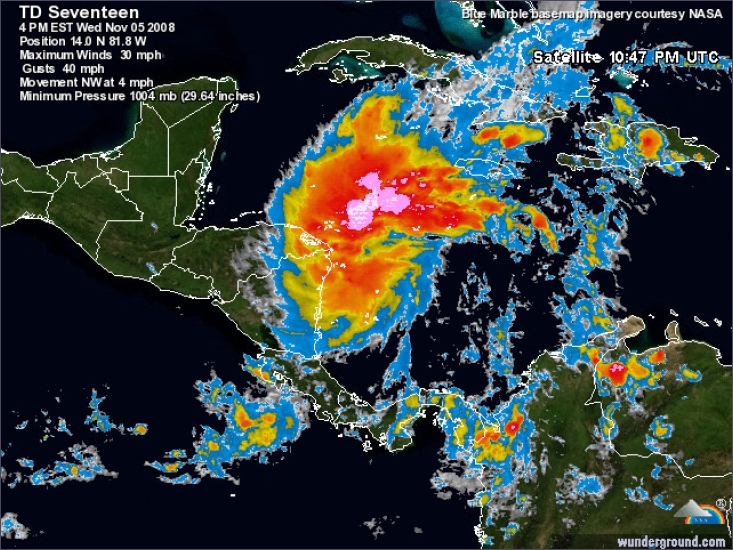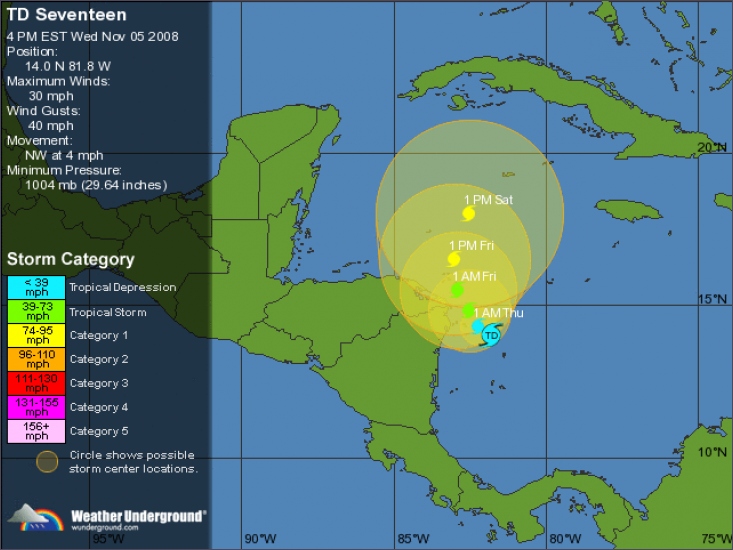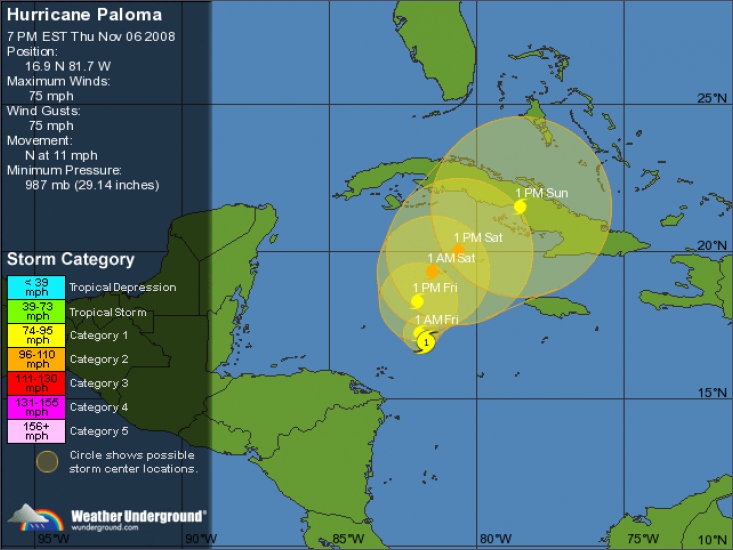The 17th tropical depression of the 2008 Atlantic hurricane season formed on Wednesday and was expected to strengthen into a storm or perhaps even a hurricane on a path that could threaten the Cayman Islands, Jamaica and Cuba, U.S. forecasters said. The depression, which would be called Tropical Storm Paloma when its top sustained winds reach 39 miles per hour, was 115 miles southeast of Cabo Gracias a Dios on the Nicaragua-Honduras border, at 4 p.m. EST, the U.S. National Hurricane Center said.
Deze foto is niet meer beschikbaar
The weather system, which formed in the last month of what experts correctly predicted would be a busier than normal Atlantic hurricane season, posed no threat to U.S. oil installations in the Gulf of Mexico, according to computer models. The storm had sustained winds of 30 mph and was moving northwest at about 5 mph, the hurricane center said.
It was expected to move toward the border of Honduras and Nicaragua only briefly before being pulled northward and then northeastward, possibly threatening the wealthy British territory of the Cayman Islands, Jamaica, storm-weary Cuba and the central or southern Bahamas.
Deze foto is niet meer beschikbaar
Impoverished Haiti, which is recovering from the ravages of four storms that killed more than 800 people in August and September, is also in the potential path. Computer models varied on the future intensity of the system. Two models called for it to reach "major" hurricane strength, Category 3 on the five-step Saffir-Simpson scale, with sustained winds of at least 111 mph, before hitting Cuba, while another did not even take it to hurricane status.
The hurricane center's official forecast called for it to become a tropical storm within a day, and a hurricane, with sustained winds of at least 75 mph, in two days.
The Atlantic season, which runs from June 1 to November 30, has seen seven hurricanes and eight tropical storms.
©Reuters/Weatherunderground
De tropische storm Paloma, die bij Nicaragua is ontstaan kan uitgroeien tot een hurricane. Mogelijk wordt Paloma dit weekeinde een orkaan van klasse 2 met winden van 150 km/uur. Verwacht wordt dat de hurricane koers zet naar de Kaaimaneilanden en midden Cuba.
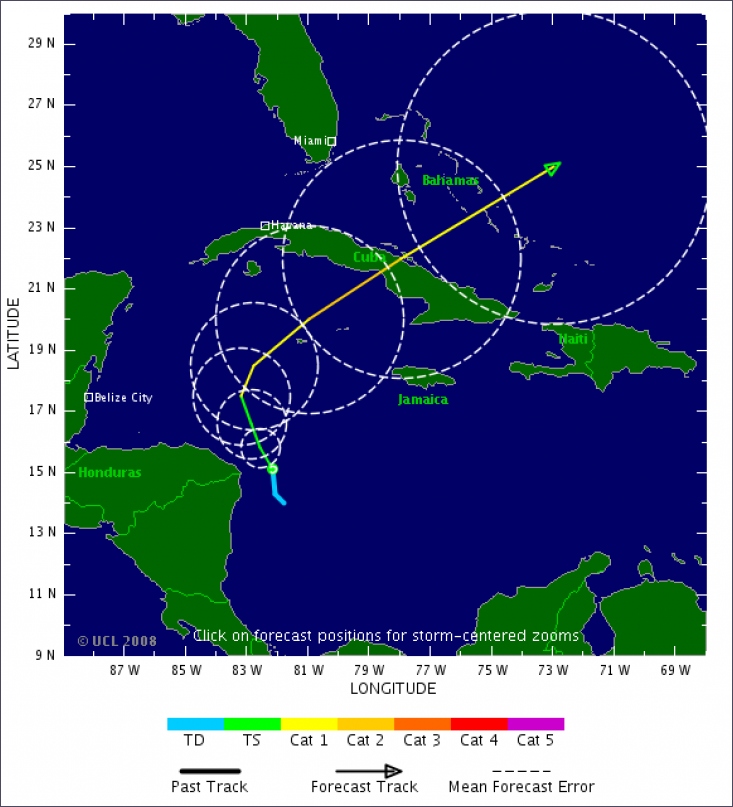
Lokaal levert Paloma op zijn tocht naar verwachting zo'n 170 mm regen op. Cuba heeft het dit jaar zwaar te verduren gekregen. Midden september trok Ike met windsnelheden van 165 km/uur dwars over het eiland en liet de hurricane en spoor van vernieling achter in Havana. Eerder die maand schreef Gustav geschiedenis in Cuba. Die hurricane deed volgens het Cubaanse Meteorologische Instituut de windmeters uitschieten tot recordsnelheden van 340 km/uur. De voorganger van Paloma, hurricane Omar, trof door zijn bijzondere koers zowel de Boven- als de Benedenwindse Eilanden met vooral schade op St Maarten.en Curacao.
Hurricane-seizoen duurt nog tot december
Paloma is de 17e tropische storm van dit seizoen. Het aantal tropische stormen en hurricanes dat het Caribisch gebied doorkruist, houdt zich aardig aan de verwachtingen. De orkaanverwachtingen voor de rest van het Atlantische orkaanseizoen, dat officieel tot 1 december loopt, hadden al aangegeven dat er iets meer tropische stormen en orkanen dan normaal zouden ontstaan. Dit hangt er sterk van af wat `normaal' word genoemd; sinds 1995 zijn er gemiddeld meer orkanen dan in de 20 jaar daarvoor. De verwachting is dat 2008 uiteindelijk rond hetzelfde, hogere, niveau uitkomt.
Stormnamen dit jaar
De storm- en hurricanenamen van dit jaar zijn, afhankelijk van het aantal dat zich ontwikkelt: Arthur, Bertha, Cristobal, Dolly, Edouard, Fay, Gustav, Hanna, Ike, Josephine, Kyle, Laura, Marco, Nana, Omar, Paloma, Rene, Sally, Teddy, Vicky en Wilfred.
©KNMI
Forecasters say Tropical Storm Paloma is strengthening and turning to the north as it approaches the Cayman Islands and Cuba. The National Hurricane Center in Miami said Thursday the storm could make landfall over Cuba as a hurricane by Sunday.
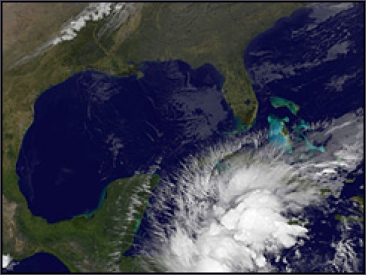
A hurricane watch is in effect for the Cayman Islands. A tropical storm watch is in effect for parts of Nicaragua and Honduras, where several inches of rain are expected. Paloma's center is located about 235 miles south of Grand Cayman and was moving north about 7 mph with sustained winds of 60 mph.
Forecasters say it could turn into hurricane with winds of 75 mph or more later Thursday night or early Friday. It's expected to make a gradual turn to the northeast later Friday or Saturday.
©CBS
Tropical Storm Paloma strengthened into a hurricane in the Caribbean on Thursday on a path that threatened Cuba, U.S. forecasters said.
Deze foto is niet meer beschikbaar
The storm's sustained winds grew to 75 miles per hour (121 km per hour) as it churned 165 miles south of Grand Cayman Island at 7 p.m. EST, the U.S. National Hurricane Center said.
©Reuters/Weatherunderground
De tropische storm Paloma heeft zich in het Caribisch gebied vrijdag ontwikkeld tot een orkaan. Paloma kent volgens Amerikaanse meteorologen in Miami windsnelheden van meer dan 120 kilometer per uur. Volgens de laatste berekeningen wordt Paloma eventjes een orkaan van de derde categorie met windsnelheden die op kunnen lopen tot 209 km/u.
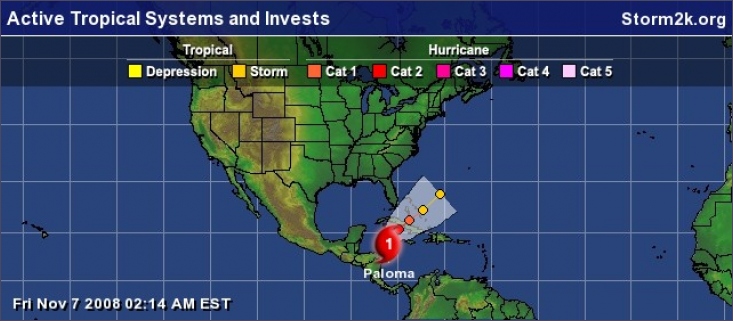
De storm bevindt zich tussen de kusten van Honduras en Jamaica ten zuiden van de Kaaiman-Eilanden en trekt in noordelijke richting. Er is een mogelijke dreiging dat centraal en oost Cuba een zondag op maandag getroffen gaat worden.
Paloma is de achtste orkaan van het seizoen.
©onweer-online

In de Caraïben heeft de tropische storm Paloma aan kracht gewonnen en zich tot een orkaan ontwikkeld. Het Amerikaans orkaancentrum in Miami schatte Paloma met windsnelheden van meer dan 120 kilometer per uur in tot een orkaan van categorie een. Voor de Kaaimaneilanden werd een orkaanwaarschuwing gegeven. Zondag zou Paloma Cuba bereiken.
Volgens de Amerikaanse meteorologen kan de storm nog krachtiger worden en als orkaan van categorie twee over de Kaaimaneilanden richting Cuba trekken. Het grootste eiland van de Antillen kreeg gedurende de regentijd van dit jaar al bezoek van twee orkanen, die enorm veel schade hebben aangericht. Paloma had zich woensdagnacht tot een tropische storm ontwikkeld voor de kusten van Honduras en Nicaragua.
©Hln
Hurricane Paloma strengthened overnight and is forecast to become a dangerous Category 3 storm this weekend, the National Hurricane Center in Miami, Florida, said Friday.

Hurricane Paloma obscures Cuba and other Caribbean islands in a satellite image taken Friday morning.
At 5 a.m. ET, Paloma was centered about 110 miles south-southwest of Grand Cayman and about 255 miles west of Montego Bay, Jamaica. The Category 1 storm had maximum sustained winds of 80 mph.
The hurricane was tracking to the north at 9 mph and was expected to continue on that path throughout Friday before gradually turning to the northeast by Saturday, forecasters said.
A hurricane warning is in effect for the Cayman Islands, which means hurricane conditions are expected there within the next 24 hours. The hurricane center warned residents to complete preparations quickly to "protect life and property."
Forecasters said they may issue watches and warnings for Cuba later Friday.
Paloma is expected to drop 5 to 10 inches of rain over the Caymans, with isolated totals of as much as 12 inches possible.
Bron:CNN
Late-Season Hurricane Expected To Gain Strength And Plow Into Cuba
Rainstorms soaked the Cayman Islands on Friday as late-season Hurricane Paloma bore down on the chain of tiny Caribbean islands, triggering a run on stores and plans to shut the main airport.
The Category 1 hurricane was expected to pass over or near Grand Cayman late Friday or early Saturday then gain strength and plow into Cuba, still recovering from two previous hurricanes this season.
Cuba's Communist Party daily Granma, recalling past late-season hurricanes such as a 1932 storm that killed about 3,000 people, said Paloma poses "a potential danger for the island." Before it reaches Cuba on Sunday it could be a Category 3 storm with winds of at least 111 mph, according to the U.S. National Hurricane Center in Miami.
Forecasters expected Paloma to weaken into a tropical storm after crossing Cuba's midsection and steer away from the United States through the Bahamas and into the Atlantic.
The Cayman Islands government urged residents to stay off the streets and began preparing for evacuations in low-lying southern coastal regions. The airport was to close Friday, according to Tourism Minister Charles Clifford, who said extra flights off the island were added late Thursday.
"I hope I'm right, but I don't think this will be a major event," Clifford said. Paloma had winds near 85 mph and forecasters said it was likely to strengthen before reaching this affluent British territory.
It could be a different story for Cuba, still reeling from Hurricanes Gustav and Ike in August and September.
At 10 a.m. EST, Paloma was about 75 miles south-southwest of Grand Cayman, moving to the north at 7 mph and expected to turn to the northeast late Friday.
Cayman Islands Gov. Stuart Jack said Friday that a British Royal Navy ship was on the way and would be available to provide humanitarian assistance if needed.
Bron:CBS.News
In afwachting van de doortocht van orkaan Paloma worden duizenden mensen in het centrum en oosten van Cuba geëvacueerd. Cuba heeft een staat van alertheid afgekondigd voor de doortocht van Paloma. Het land begint met de preventieve evacuatie van de acht centraal en oostelijk gelegen provincies, zo meldt de Civiele Bescherming.
Het oog van de cycloon, die zich met een snelheid van slechts 9km/h voortbeweegt, bevindt zich 50 km ten zuiden van de Kaaimaneilanden en op 440 km van Camagüey (centrum Cuba). "Paloma kan nog in sterkte toenemen tot zaterdag. Zijn winden zullen in de loop van zaterdagavond de zuidkust van Cuba bereiken", zo zei José Rubiera, directeur van het Insmet, op de Cubaanse televisie.
Veiligheid
Meer dan 85.000 studenten die zich in Santiago en Camagüey bevonden, moesten gisteren huiswaarts keren, zo meldt de Civiele Bescherming nog. Zo'n 3.000 buitenlandse toeristen die zich op de noordelijke eilandjes van Ciego de Avila bevonden, werden in veiligheid gebracht.
Cuba werd eind augustus-begin september reeds getroffen door twee orkanen, Ike en Gustav. Volgens de laatste schattingen van de Cubaanse autoriteiten vielen hierbij zeven doden en werd er voor meer dan 9 miljard dollar schade aangericht. Het orkaanseizoen begint in deze regio in juni en eindigt einde november.
©Hln | Gewijzigd: 30 januari 2017, 10:13 uur, door Joyce.s
Paloma became an "extremely dangerous" Category 4 hurricane early Saturday, dumping wind and rain on the Cayman Islands and threatening to strike hurricane-ravaged Cuba as a major storm, forecasters said. The late-season storm had top sustained winds of near 140 mph and was expected to bring total rainfall accumulations of 5 to 10 inches over the Cayman Islands as well as central and eastern Cuba.
The new forecast from the National Hurricane Center in Miami called for Paloma to make landfall in Cuba as a major hurricane late Saturday or early Sunday with maximum-sustained winds of at least 111 mph. Cuba already is suffering from Hurricanes Ike and Gustav, which struck the island earlier this season and together caused an estimated $9.4 billion in damage.

Waves caused by the arrival of Hurricane Paloma crash
over a dock in Spots Bay in George Town along the southern coast of
Grand Cayman, Nov. 7, 2008. (AP Photo/Joanna Lewis)
"It's not like it's new to them, unfortunately," said Dave Roberts, a U.S. Navy hurricane specialist. Cuban official newspaper Granma, recalling past late-season hurricanes such as a 1932 storm that killed about 3,000 people, said Paloma poses "a potential danger for the island."
At 7 a.m. EST, the center of Paloma was just southeast of Cayman Brac and moving toward the northeast near 8 mph. The storm's center was expected to move away from Little Cayman and Cayman Brac on Saturday morning and was about 165 miles southwest of Camaguey, Cuba.

Palm trees and warning flags are blown by strong winds brought
by the arrival of Hurricane Paloma in George Town, Grand Cayman,
Friday, Nov. 7, 2008. (AP Photo/Joanna Lewis)
The Cayman Islands government asked all hotels to remove guests from the ground and first floors. Nearly 40 people were already staying in the islands' seven shelters. Water service across Grand Cayman was turned off, and power would likely be cut as the storm neared, hazard management director Barbara Carby said. "We have asked everybody to come off the streets and to be home and safe right now," she said.
Earlier, stranded tourists watched dark clouds gather and saw the storm whip up 10-foot waves from their hotels or beachfront restaurants. "It was a real surprise," said Rick Douglas, 50, of Toronto, who checked weather Web sites before flying to the Caribbean. "It just said there was a tropical depression starting, but I didn't think it would turn into anything serious."
His wife, Susan Douglas, was confident they would be safe as long as they follow orders. "Grand Cayman has been there and done that, so they are prepared," she said. Havana's communist government activated the early stages of its highly organized civil defense system. In central and eastern Cuba, people were advised to stay tuned to state media for news of Paloma's progress and be ready to evacuate.

Radar imagery of Hurricane Paloma, Nov. 8, 2008. (NOAA)
Paloma was aiming toward the central-eastern city of Camaguey, which was particularly hard-hit by Hurricane Ike in September. Ike and Hurricane Gustav, which struck the island in late August, together caused an estimated $9.4 billion in damage. Nearly a third of Cuba's crops were destroyed, causing widespread shortages of fresh produce and prompting authorities to order the planting of vegetable greens and other short-term vegetables.
Forecasters expect Paloma to weaken into a tropical storm after striking Cuba and then steer south of Florida through the Bahamas and into the Atlantic. Cayman Islands Gov. Stuart Jack said Friday that a British Royal Navy ship was on the way and would be available to provide humanitarian assistance if needed. The airport closed Friday morning after extra flights were added to fly out some people late Thursday.
Muniran Charran, a construction worker from Guyana, said he first heard about the storm Thursday night over the radio.
"We didn't really have any time to prepare because the banks and the stores all closed so early today," he said. He was drinking beers with friends in the downstairs lobby of their beachfront apartment complex. "What we've been seeing all day is just a lot of rain and strong winds," Guyana native Shik Khan said. "We hope that when we wake up, everything is fine."
Bron:CBS.News
Vrijdag heeft de tropische storm Paloma zich in het Caribische gebied tot orkaan ontwikkeld. Met snelheden tot ongeveer 215 kilometer per uur raast deze inmiddels ‘zeer gevaarlijke’ orkaan op dit moment richting de kust van Cuba. Het is de achtste orkaan van het seizoen, dat nog tot eind november duurt.

Cuba kampt nu al met erg harde wind.
Paloma ontwikkelde zich afgelopen woensdagnacht voor de kust van Honduras en Nicaragua. Het warme zeewater van de Caribische Zee is natuurlijk een goede voedingsbron, waardoor Paloma vrij snel uitgroeide tot een categorie 2 orkaan.
Inmiddels is het een major hurricane, categorie 4, en ligt hij ongeveer 65 kilometer van de Kaaiman-Eilanden. Verwacht wordt dat het bijbehorende windveld vanavond de zuidkust van Cuba bereikt. Het oog ligt nog een paar honderd kilometer van de kust en beweegt vrij langzaam, met ongeveer 9 kilometer per uur, naar het vaste land van het grootste eiland van de Antillen. Verwacht wordt dat hij zondag de Cubaanse kust bereikt.

De bereikte snelheden van orkaan Paloma tot nu toe.

De route tot nu toe en de nog verwachte route later deze week.
Cuba werd eind augustus en begin september al eerder getroffen door de orkanen, Gustav en Ike. Hierbij vielen volgens Cubaanse autoriteiten 7 doden en werd er voor meer dan 7 miljard dollar schade aangericht. Gustav kwam volgens het Cubaanse Meteorologische instituut tot recordsnelheden van 340 kilometer per uur. Maar ook nu is de kans op schade groot. Een categorie 4 orkaan, op de schaal van Saffir-Simpson, is zo sterk dat daken met gemak worden weggeblazen en met verwachte regenhoeveelheden van 250 millimeter is wateroverlast niet uitgesloten.

De windhistorie van Paloma.
Meer tropische stormen en orkanen
Volgens het National Hurricane Center is de Atlantische Oceaan op dit moment onderhevig aan ‘een cyclus van verhoogde orkaanactiviteit’. Ook in de periode van 1940 tot 1960 was dit het geval. Volgens de directeur van het National Hurricane Center gaat het hier om een natuurlijke cyclus, die iedere 25 tot 40 jaar terugkeert. Het inmiddels vaak in de pers aangehaalde effect van het broeikaseffect wijst hij van de hand. De opwarming van de aarde heeft geen directe invloed op het aantal tropische stormen, maar het warme zeewater heeft volgens hem wel meer hele zware stormen tot gevolg.
Recordjaren
Sinds 1851 wordt het aantal tropische stormen bijgehouden en tot nu toe staat 2005 genoteerd als het recordjaar met een aantal van 22. Vier orkanen, Emily, Katrina, Rita en Wilma, bereikten toen zelfs de vijfde categorie. 1933 ligt daar strak achter met een aantal van 21. Het jaar 2008 scoort met een aantal van 16 tropische stormen, waarvan er 8 orkaan werden, ook ruim binnen de categorie ‘boven normaal’.
Bronnen Meteo-Consult en NOAA
Authorities in Cuba are evacuating tens of thousands of people from low-lying coastal areas ahead of the arrival of Hurricane Paloma.
Forecasters have warned that the category four storm could cause severe devastation from parts of the island that is still recovering from the effects of previous hurricanes.
All of Cuba's central and eastern provinces have been placed on hurricane alert triggering mass evacuations from low lying coastal regions and other flood prone areas.
Hurricane Paloma has picked up speed since sweeping through the Cayman islands where storm surges and torrential rain caused flooding and blackout.
This late season hurricane has risen to an extremely dangerous category four storm with sustained winds of 225 kilometres per hour.
These may ease slightly before making landfall in Cuba late tonight or early tomorrow morning.
bron:abcnews
De orkaan Paloma (categorie 3) bereikte gisteravond Cuba met windsnelheden tot 200 km/u. Honderdduizenden personen werden preventief geëvacueerd. Paloma richtte al grote schade aan op de Kaaimaneilanden.
Verkeer verboden
In de Cubaanse provincies Camagüey, Las Tunas, Holguin, Granma, Santiago de Cuba en Guantanamo is alle auto- en voetgangersverkeer zonder speciale toestemming verboden. Dit is ook het geval aan de zuidkust van Ciego de Avila, waar maximale alertheid is afgekondigd.
Honderdduizenden personen werden geëvacueerd uit overstromingsgebieden en kwetsbare plaatsen. Ongeveer 3.000 buitenlandse toeristen die zich op de noordelijke eilandjes van Ciego de Avila bevonden, werden in veiligheid gebracht.
Hulp weigeren
In een plaatselijke krant riep oud-president Fidel Castro de bevolking op moed te houden. Bovendien liet hij weten dat zijn land alle hulp van de VS zal weigeren als het Amerikaanse embargo, dat al 46 jaar standhoudt, niet opgeheven wordt.
©Hln | Gewijzigd: 30 januari 2017, 10:13 uur, door Joyce.s
Orkaan Paloma, die momenteel over het oosten van Cuba trekt, is afgezwakt naar categorie 1, de laagste op de schaal van Saffir-Simpson.
"Paloma is een orkaan van categorie 1, met windsnelheden tot 140 km per uur, en zou later op de dag nog kunnen afzwakken tot een tropische storm en morgen, dicht bij de Bahamas, een tropische depressie worden", aldus het Amerikaanse orkaancentrum.
Paloma, die gisteravond het centrum van Cuba trof met een kracht van categorie 3, zou vandaag Cuba verlaten. Volgens de Cubaanse autoriteiten is er schade, maar vielen er geen slachtoffers.
©Hln | Gewijzigd: 30 januari 2017, 10:13 uur, door Joyce.s
Na honderden huizen op Cuba te hebben verwoest zwakte de orkaan Paloma af tot een tropische depressie. Dat heeft het Nationale Orkaancentrum in Miami gezegd.
Vanavond bevond Paloma zich 25 kilometer ten zuid-zuidwesten van Camaguey op Cuba. De aanvankelijke windsnelheden van 230 kilometer per uur namen af tot 55 kilometer per uur. Maandag zal Paloma in de buurt van de noordkust van Cuba aankomen.
Stroomuitval
De storm rukte op Cuba een grote zendmast uit de grond, waardoor het eiland met stroomuitval te maken kreeg. Ook telefoonlijnen werkten niet meer. Dodelijke slachtoffers werden er niet gemeld.
©Hln | Gewijzigd: 30 januari 2017, 10:14 uur, door Joyce.s

 Berichtgeving over de orkaan Paloma
Berichtgeving over de orkaan Paloma

